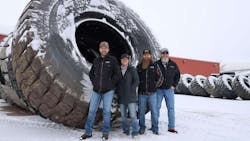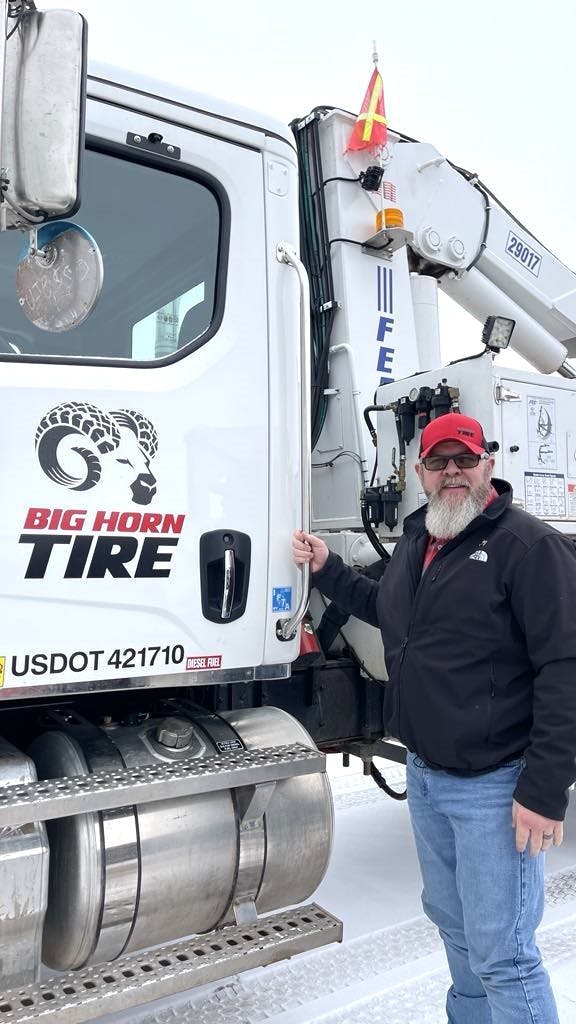Not far from where General George Armstrong Custer made his famous last stand sits another Big Horn that’s fighting a battle of its own.
Since its founding in 1964, Gillette, Wyo.-based Big Horn Tire has engaged in a daily struggle to lower its clients’ operating costs — a conflict that the OTR tire dealership has been winning thanks to a relentless focus on premium customer service and self-investment.
“We have our fingers on the pulse of mining activity in this part of the country,” says Craig Stevens, general manager of Big Horn Tire, whose operations span the vast, sprawling states of Wyoming and Montana, plus parts of Idaho and the Dakotas.
“Some of our stores have seen anywhere between 150% to 400% growth” despite a relatively soft market, he notes — a testament to the value Big Horn Tire delivers to its customers.
Superior service
Mining operations make up the bulk of Big Horn Tire’s customer base. The dealership sells the gamut of mining tires and sizes, from smaller SKUs up to giant, 63-inch tires that are mounted on massive haul trucks. OTR tire brands offered include BKT, Bridgestone, Galaxy, Goodyear, Maxam, Michelin and Yokohama. But Big Horn Tire’s most important asset is its people, says Stevens.
“We have about 36 Mine Safety and Health Administration and Tire Industry Association- trained mining tire technicians who are embedded in mines every day.
“They don’t even come into the shop. They work rotational shifts at the mines. They work 12-hour days. When blizzards come through, they might not even have a chance to come home,” opting instead to hunker down locally to get a head start on the next day’s work.
“We have well over 200 years of combined mining tire technical expertise on staff right now and that’s really hard to beat,” he says. “We’re not perfect. Nobody is. But we’re very good at what we do. When you have that kind of bench, it’s really nice.”
Big Horn Tire’s technicians and salespeople provide a wide range of after-sale service to mining tire customers, “everything from TMPH (ton-mile per hour) studies and mine site audits to tire management programs, data collection and analysis and all the account management stuff — to help our customers reduce their total cost of ownership.”
Big Horn Tire has also diversified into servicing construction companies and commercial trucking fleets. Stevens says the dealership “can pretty much tailor all of our mine services down to smaller customers. Having guys who can hop on a service truck and go out and perform the work is a big part of it.”
As its customers and pool of available labor continue to evolve, Big Horn Tire also evaluates — and if necessary, adjusts — what it offers.
“In 1974, we signed on as a Bandag retreader and we were a retreader for almost 50 years,” says Stevens. “It was a value-add for our customers. But in 2022, we chose to shut (the plant) down because the gentleman we had running it — who was very talented and had done it for 35 years — was retiring and we couldn’t find anyone to replace him.”
Market forces also contributed to Big Horn Tire’s decision to exit retreading. “If you look at the transition happening in the commercial tire market, a lot of retread shops are closing down and customers are going to these mega-shops. Anymore, you have to crank out volume to have any kind of profitability. It would have been very, very challenging for us to survive” as a retreader.
Constant reinvestment
OTR tire service can take a toll on the sturdiest of machines, which is why Big Horn Tire constantly reinvests in its equipment, including service trucks. “We employ one full-time, heavy-duty mechanic who works on nothing but our large OTR trucks, our tire handlers — that kind of thing. He probably works 70 hours a week, 50 weeks a year. If he needs to travel to a remote location, he can. But most of the time, he stays here in the Gilette market,” where Big Horn Tire’s main facility is located.
“We’re always looking at what we need to replace, too,” says Stevens. “A new giant tire handler can cost you up to $750,000. There’s a lot of other equipment. We just recently purchased two new machines for our giant OTR tire repair shop. So it’s not just tires. It’s alignment machines. It’s our repair equipment.”
Staying on top of maintenance “requires a lot of sitting down and talking through stuff. We’re a flat organization. If we feel like we need to make a change, we can do so almost immediately.”
Big Horn Tire constantly calibrates its product portfolio, adjusting inventory and offerings to meet the ever-changing needs of customers, many of whom in recent years have become more open to using tires made by alternative suppliers.
“I can tell you with pretty good accuracy that in the next three to five years, you’re going to have four to possibly five really superior players in the giant OTR tire market, whereas in the past, you had fewer. And that will open even more possibilities for mining tire customers.”
The next frontier
Demand for mining tires where Big Horn Tire does business “was really robust in 2023,” says Stevens. “It was steady and solid for us and probably one of our best years ever for sales and profitability. In 2024, we saw a softening and that was across all segments. We saw softening in mining. We saw softening in construction. I expect that will continue.
“People are really watching their cash flow. When you’re mining, you’re buying a $60,000 tire for your piece of equipment. Customers are dealing with a lot of unknowns. That’s kind of the way things are today.”
This won’t stop Big Horn Tire from seeking expansion opportunities. Two of its current locations were acquisitions.
“We keep our eyes open,” says Stevens. “We’re not a Pomp’s Tire Service or a Southern Tire Mart. We’re not going to snag 16 locations at once.
“We want to stay close to our geography, but we do have our eyes on a couple of areas. Whatever we do next, we’ll likely focus on what we’re best at, which is OTR.”
Employee recruitment and retention will remain challenges in the OTR tire segment, but this doesn’t worry Stevens. “OTR tire salespeople and technicians are some of the most highly skilled, sought-after people in the industry. Whether you’re changing a 63-inch tire or a smaller tire, there’s a huge need for people with experience and expertise.”
Stevens says the average tenure of employment at Big Horn Tire is 11 years. He credits employee longevity to “the family culture we have here.
“We feel very much appreciated” by the dealership’s owners.
John Crump Sr. and Doris Crump, along with her brother, Dwayne Newton, founded Big Horn Tire. The dealership is currently owned by John Crump Sr., John Crump Jr. and Cathy Stalcup.
“We’re proud of what we’ve built and we’re hoping to grow that.”
About the Author
Mike Manges
Editor
Mike Manges is Modern Tire Dealer’s editor. A 28-year tire industry veteran, he is a three-time International Automotive Media Association Award winner, holds a Gold Award from the Association of Automotive Publication Editors and was named a finalist for the prestigious Jesse H. Neal Award, the Pulitzer Prize of business-to-business media, in 2024. He also was named Endeavor Business Media's Editor of the Year in 2024. Mike has traveled the world in pursuit of stories that will help independent tire dealers move their businesses forward. Before rejoining MTD in 2019, he held corporate communications positions at two Fortune 500 companies and served as MTD’s senior editor from 2000 to 2010.


